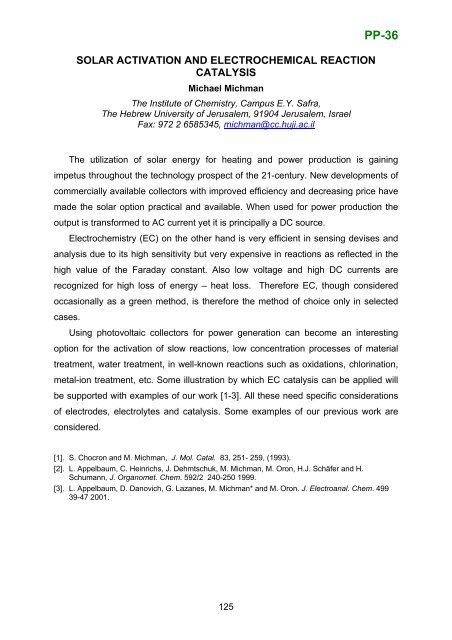Boreskov Institute of Catalysis SB RAS, Novosibirsk, Russia
Boreskov Institute of Catalysis SB RAS, Novosibirsk, Russia
Boreskov Institute of Catalysis SB RAS, Novosibirsk, Russia
- No tags were found...
Create successful ePaper yourself
Turn your PDF publications into a flip-book with our unique Google optimized e-Paper software.
SOLAR ACTIVATION AND ELECTROCHEMICAL REACTIONCATALYSISMichael MichmanThe <strong>Institute</strong> <strong>of</strong> Chemistry, Campus E.Y. Safra,The Hebrew University <strong>of</strong> Jerusalem, 91904 Jerusalem, IsraelFax: 972 2 6585345, michman@cc.huji.ac.ilPP-36The utilization <strong>of</strong> solar energy for heating and power production is gainingimpetus throughout the technology prospect <strong>of</strong> the 21-century. New developments <strong>of</strong>commercially available collectors with improved efficiency and decreasing price havemade the solar option practical and available. When used for power production theoutput is transformed to AC current yet it is principally a DC source.Electrochemistry (EC) on the other hand is very efficient in sensing devises andanalysis due to its high sensitivity but very expensive in reactions as reflected in thehigh value <strong>of</strong> the Faraday constant. Also low voltage and high DC currents arerecognized for high loss <strong>of</strong> energy – heat loss. Therefore EC, though consideredoccasionally as a green method, is therefore the method <strong>of</strong> choice only in selectedcases.Using photovoltaic collectors for power generation can become an interestingoption for the activation <strong>of</strong> slow reactions, low concentration processes <strong>of</strong> materialtreatment, water treatment, in well-known reactions such as oxidations, chlorination,metal-ion treatment, etc. Some illustration by which EC catalysis can be applied willbe supported with examples <strong>of</strong> our work [1-3]. All these need specific considerations<strong>of</strong> electrodes, electrolytes and catalysis. Some examples <strong>of</strong> our previous work areconsidered.[1]. S. Chocron and M. Michman, J. Mol. Catal. 83, 251- 259, (1993).[2]. L. Appelbaum, C. Heinrichs, J. Dehmtschuk, M. Michman, M. Oron, H.J. Schäfer and H.Schumann, J. Organomet. Chem. 592/2 240-250 1999.[3]. L. Appelbaum, D. Danovich, G. Lazanes, M. Michman* and M. Oron. J. Electroanal. Chem. 49939-47 2001.125
















